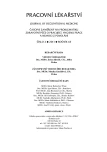A occupational preventive health care of workers at risk of cytostatic drugs in the Faculty Hospital Hradec Králové
Authors:
J. Chaloupka; K. Boušová; J. Bubeníčková; H. Rinnová
Authors‘ workplace:
Klinika nemocí z povolání LF UK a FN Hradec Králové, přednosta Doc. MUDr. Jiří Chaloupka, CSc.
Published in:
Pracov. Lék., 63, 2011, No. 2, s. 72-78.
Category:
Original Papers
Overview
Manipulation with cytostatic drugs and their aplication to patients causes contamination of external environment and long-term professional exposure in health care staff. Carcinogenic, teratogenic effects and reproduction and system toxicity are the possible consequences of the exposure. The method of cytogenetic analysis of peripheral lymphocytes (CAPL) which detects structural and numerical aberations in cultivated peripheral lymphocytes is used as a biomarker of the early biological effect of mutagenic and carcinogenic substances.
In 2006, 2008 and 2010, 150 individuals were examined using the CAPL method in the Faculty Hospital Hradec Králové. The mean values of the number of chromosomal aberrations were 3.04 %, 3.79 % and 3.41 % in respective years indicating increased exposure to genotoxic substances. The lowest values were found in employees of the hospital pharmacy (2.94 %) and the lung clinic (3.04 %). Higher values were found in employees of children hematooncology (3.64 %) and the clinic of oncology and radiotherapy (3.62 %). Higher values were found in smokers compared to nonsmokers. Results are considered as a nonspecific complex indicator influenced with a number of factors (level of exposure, activity of reparatory mechanisms, activity of immune system, susceptibility to genotoxic substances, life style factors, etc.). It is necessary to take measures to decrease the exposure of employees in order to reduce health risks.
Key words:
cytostatic drugs, facility health care, cytogenetic analysis of peripheral lymphocytes, chromosomal aberrations, health care system
Sources
1. ALBERTINI, R. J. et al. IPCS guidelines for the monitoring of genotoxic effects of carcinogens in humans. Mutat. Res., 2000, 463, s. 111–172.
2. BIRÓ, A. et al. Immunotoxicity Monitoring of Hospital Staff Occupationally Exposed to Cytostatic Drugs. Pathol. Oncol. Res., 2011, 17, s. 301–308.
3. BONASSI, S. et al. Chromosomal aberrations and risk of cancer in humans: an epidemiologic perspective. Cytogenet. Genome Res., 2004, 104, s. 376–382.
4. BOUGHATTAS, A. B. et al. Genotoxic risk assessment of nurses handling antineoplastic drugs. Ann Biol Clin., 2010, 68, 5, s. 545–553.
5. CONNOR, T. H. et al. Evaluation of antineoplastic drug exposure of health care workers at three university-based US cancer centers. J. Occup. Environ. Med., 2010, 52, 10, s. 1019–1027.
6. CONNOR, T. H., MCDIARMID, M. A. Preventing Occupational Exposures to Antineoplastic Drugs in Health Care Settings. CA Cancer J. Clin., 2006, 56, s. 354–365.
7. DOLEŽALOVÁ, L. et al. Kontaminace chemoterapeutického stacionáře v Masarykově onkologickém ústavu: hodnocení účinnosti zavedených nápravných opatření. Pracovní lékařství, 2010, 59, 4, s. 158–163.
8. MORETTI, M. et al. A study protocol for the evaluation of occupational mutagenic/ carcinogenic risks in subjects exposed to antineoplastic drugs: a multicentric project. BMC Public Health, 2011, 11, s. 195.
9. NIOSH List of Antineoplastic and Other Hazardous Drugs in Healthcare Settings. NIOSH, 2010. Dostupé na www: http://www.cdc.gov/niosh/docs/2010-167/pdfs/2010-167.pdf
10. NIOSH Workplace Safety & Health Topics. Occupational Exposure to Antineoplastic Agents. NIOSH, 2011. Dostupé na www: http://www.cdc.gov/niosh/topics/antineoplastic/
11. OČADLÍKOVÁ, D., BAVOROVÁ, H., ŠMÍD, J. Metody biologického monitorování genotoxických účinků faktorů prostředí. Cytogenetická analýza periferních lymfocytů. Acta hygienica, epidemiologica et microbiologica, SZÚ Praha, 2007, 1, 30 s.
12. Preventing Occupational Exposure to Antineoplastic and Other Hazardous Drugs in Health Care Settings. NIOSH Publication No. 2004-165, Dostupé na www:
http://www.cdc.gov/niosh/docs/2004-165/.
13. RATNER, P.A. et al. Cancer incidence and adverse pregnancy outcome in registered nurses potentially exposed to antineoplastic drugs. BMC Nurs., 2010, s. 9–15.
14. RÖSSNER, P. et al. Chromosomal aberrations in lymphocytes of healthy subjects and risk of cancer. Environ. Health Perspect., 2005, 113, s. 517–520.
15. SKOV, T. et al. E. Leukemia and reproductive outcome among nurses handling antineoplastic drugs. Br. J. Indust. Med., 1992, 49, s. 855–861.
16. ŠMERHOVSKÝ, Z. et al. Risk of cancer in an occupationally exposed cohort with increased level of chromosomal aberrations. Environ. Health Perspect., 2001, 109, s. 41–45.
17. VILLARINI, M. et al. Assessment of primary, oxidative and excision repaired DNA damage in hospital personnel handling antineoplastic drugs. Mutagenesis, 2011, 26, s. 359–369.
Labels
Hygiene and epidemiology Hyperbaric medicine Occupational medicineArticle was published in
Occupational Medicine

2011 Issue 2
Most read in this issue
- Professional isthmus lesions of nervus ulnaris in the elbow – anatomical, physiological principles, pathogenesis
- A occupational preventive health care of workers at risk of cytostatic drugs in the Faculty Hospital Hradec Králové
- Varices of lower extremities in relation to genetic factors and physical work and leisure load factors
- Detection of 1-hydroxypyrene in urine of a coke plant workers
